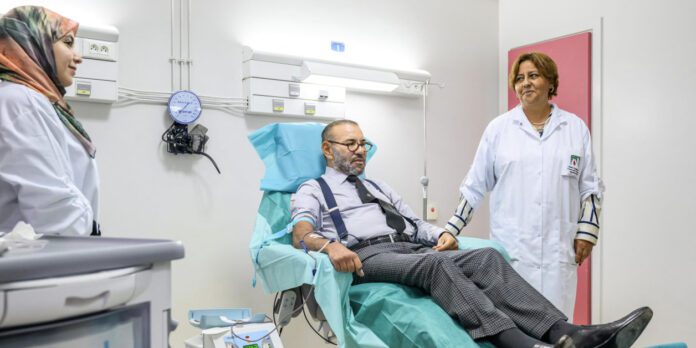Hopes of finding survivors are fading in Morocco, four days after a devastating earthquake in the Marrakesh region, where King Mohammed VI visited the injured. The earthquake left 2,901 dead and 5,530 injured, according to the latest official report.
The Red Cross has launched an appeal for funds worth around 100 million euros to support relief operations, after releasing one million Swiss francs from its Emergency Fund to support the Moroccan Red Crescent's activities on the ground.
King Mohammed VI visited Marrakesh's university hospital center before donating blood. He “visited the intensive care unit and the inpatient unit for earthquake victims” to find out about the condition in health of the injured, as well as the care provided to them.
Moroccan volunteers and rescuers, supported by foreign teams, are trying to speed up the search to find possible survivors and provide shelter to hundreds of families who have lost their homes. But in some isolated areas, residents say they are left to fend for themselves.
“Fear of the rains”
In Douzrou, an earthquake-ravaged village located 80 kilometers southwest of Marrakesh, concern can be seen on the faces of survivors, who have set up makeshift shelters. About a hundred people died in this town located at the beginning of the High Atlas mountain range, according to residents.
“It is important that we receive care, we cannot survive for long in the wild. The weather conditions are very harsh. We fear the worst with the arrival of winter”, worries Ismaïl Oubella, 36, who lost three children (3, 6 and 8 years old), his pregnant wife and his mother.
“We want to be relocated as quickly as possible, we lost everything, even our livestock. We remove the dead ourselves” from the rubble, alarms Hossine Benhammou, 61 years old. Nine members of his family, including his daughter and two granddaughters, died.
A team of 20 rescuers from UK International Search and Rescue Team (UK-ISAR) arrived at the scene. “Residents managed the situation, but we will send dogs” to see if there are people under the rubble, team leader Steve Willitt told AFP. “We are afraid of the rains that could cut there unpaved road leading to our village. We run the risk of dying of hunger”, confided resident Lahcen Ouhmane, 68 years old.
Field hospitals
In the town of Amizmiz, about an hour away, bags of survivors are huddled around a semi-trailer, waiting for food aid distributed by volunteers. “It’s not the government that helps, it’s the people,” says Abdelilah Tiba, 28, voluntarily. “What will we do when people stop helping us?” » worries Fátima Benhamoud, 39 years old.
According to Unicef, around 100,000 children were affected by the earthquake in Morocco, where they represent almost a third of the population. The UN organization said it had “mobilized humanitarian personnel to support an immediate response on the ground”.
The head of the Moroccan government, Aziz Akhannouch, guaranteed that “citizens who lost their homes will receive compensation”. According to him, solutions for homeless people are currently being studied.
The villages closest to the epicenter of the earthquake still remain inaccessible due to earth penetrations. In some landlocked areas, helicopters fly back and forth to transport food, according to AFP journalists. The Moroccan army has created field hospitals to treat the wounded in landlocked areas, such as the village of Asni, in the devastated province of Al-Haouz, just over an hour from Marrakesh.
The earthquake reached magnitude 7 seconds at the Moroccan Center for Scientific and Technical Research (6.8 seconds at the American Institute of Geophysics, USGS). It is the most powerful ever measured No Morocco.
(with AFP)

